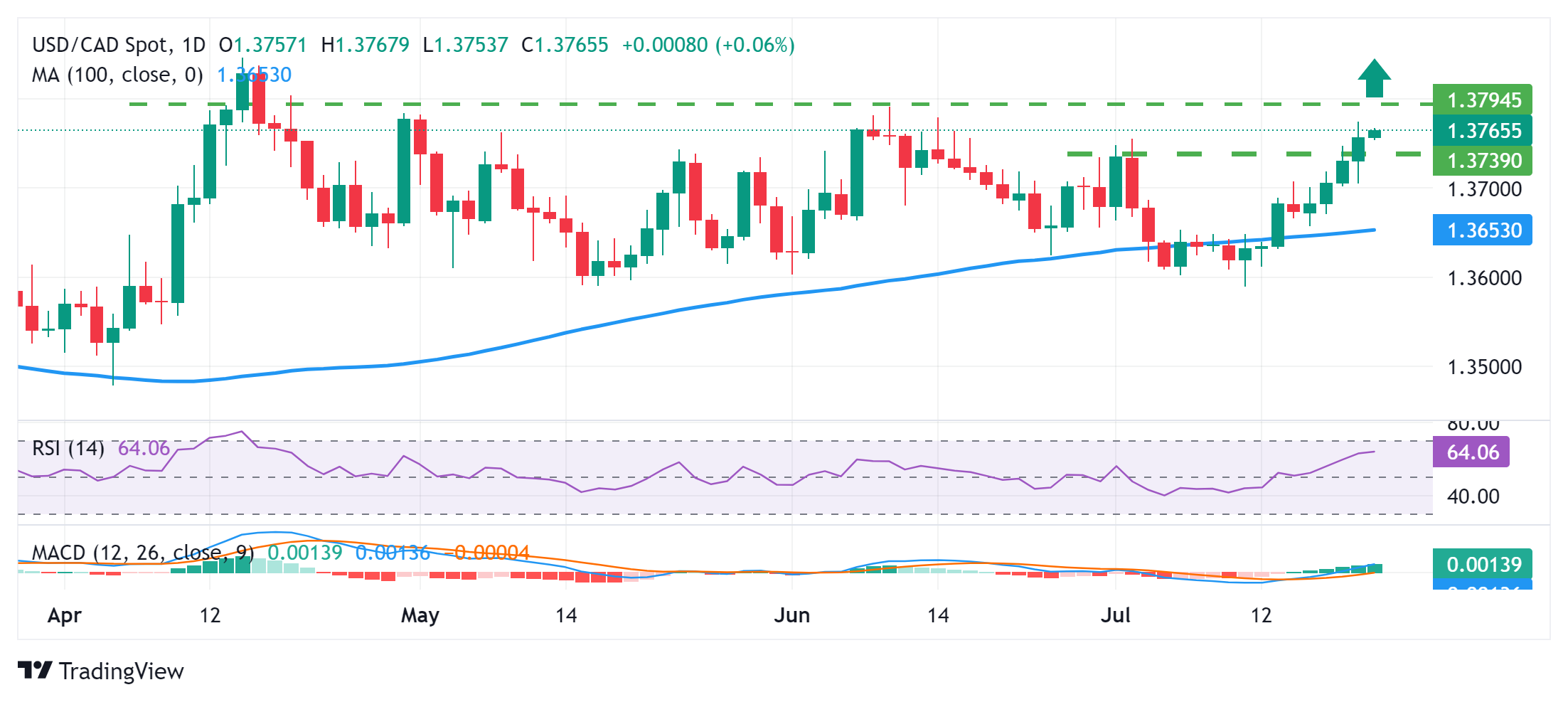- USD/CAD is trading with a positive bias for the fifth consecutive day, approaching a multi-week high.
- The rally is led by the recent drop in oil prices and appears unaffected by a weaker USD.
- The technical setup favors bullish traders and supports the prospects for a further upward move.
The USD/CAD pair attracted some buyers for the fifth consecutive day on Tuesday and traded above the 1.3750 area during the Asian session, approaching a six-week peak touched the previous day.
The recent drop in crude oil prices to an over one-month low is seen as a key factor undermining the commodity-linked Canadian Dollar and acting as a tailwind for the USD/CAD pair. Meanwhile, the rally seems unaffected by the emergence of some selling around the US Dollar (USD), which remains pressured by bets of an interest rate cut by the Federal Reserve (Fed) in September.
From a technical perspective, the overnight sustained break and close above the 1.3740 supply zone could be seen as a fresh trigger for bullish traders. Moreover, oscillators on the daily chart remain in the positive territory and are still far from being in the overbought zone. This, in turn, validates the positive bias and suggests that the path of least resistance for the USD/CAD pair is to the upside.
Some follow-through buying beyond the 1.3775 zone, or the multi-week high set on Monday, will reaffirm the constructive outlook and allow the bulls to reclaim the 1.3800 level. The momentum could extend further and take the USD/CAD pair back towards the yearly high, around the 1.3845 region touched on April 16.
On the other hand, weakness below the 1.3740 resistance breakout point is likely to attract fresh buyers and remain capped near the 1.3700 round figure. A convincing break below the latter could trigger some technical selling and drag the USD/CAD pair towards the 100-day Simple Moving Average (SMA) support, currently situated near the 1.3655 region, which should now act as a pivotal point.
USD/CAD daily chart
Canadian Dollar FAQs
The key factors determining the Canadian dollar (CAD) are the level of interest rates set by the Bank of Canada (BoC), the price of oil, Canada’s main export, the health of its economy, inflation and the trade balance, which is the difference between the value of Canadian exports and its imports. Other factors include market sentiment, i.e. whether investors are betting on riskier assets (risk-on) or looking for safe assets (risk-off), with risk-on being positive for the CAD. As its largest trading partner, the health of the US economy is also a key factor influencing the Canadian dollar.
The Bank of Canada (BoC) exerts significant influence over the Canadian dollar by setting the level of interest rates that banks can lend to each other. This influences the level of interest rates for everyone. The BoC’s main objective is to keep inflation between 1% and 3% by adjusting interest rates up or down. Relatively high interest rates are generally positive for the CAD. The Bank of Canada can also use quantitative easing and tightening to influence credit conditions, with the former being negative for the CAD and the latter being positive for the CAD.
The price of oil is a key factor influencing the value of the Canadian dollar. Oil is Canada’s largest export, so the price of oil tends to have an immediate impact on the value of the CAD. Generally, if the price of oil rises, the CAD rises as well, as aggregate demand for the currency increases. The opposite occurs if the price of oil falls. Higher oil prices also tend to lead to a higher probability of a positive trade balance, which also supports the CAD.
Although inflation has traditionally always been considered a negative factor for a currency, as it reduces the value of money, the opposite has actually occurred in modern times, with the relaxation of cross-border capital controls. Higher inflation typically leads central banks to raise interest rates, which attracts more capital inflows from global investors looking for a lucrative place to store their money. This increases demand for the local currency, which in Canada’s case is the Canadian dollar.
The released macroeconomic data measures the health of the economy and can have an impact on the Canadian Dollar. Indicators such as GDP, manufacturing and services PMIs, employment and consumer confidence surveys can influence the direction of the CAD. A strong economy is good for the Canadian Dollar. Not only does it attract more foreign investment, but it can encourage the Bank of Canada to raise interest rates, which translates into a stronger currency. However, if the economic data is weak, the CAD is likely to fall.
Source: Fx Street
I am Joshua Winder, a senior-level journalist and editor at World Stock Market. I specialize in covering news related to the stock market and economic trends. With more than 8 years of experience in this field, I have become an expert in financial reporting.








